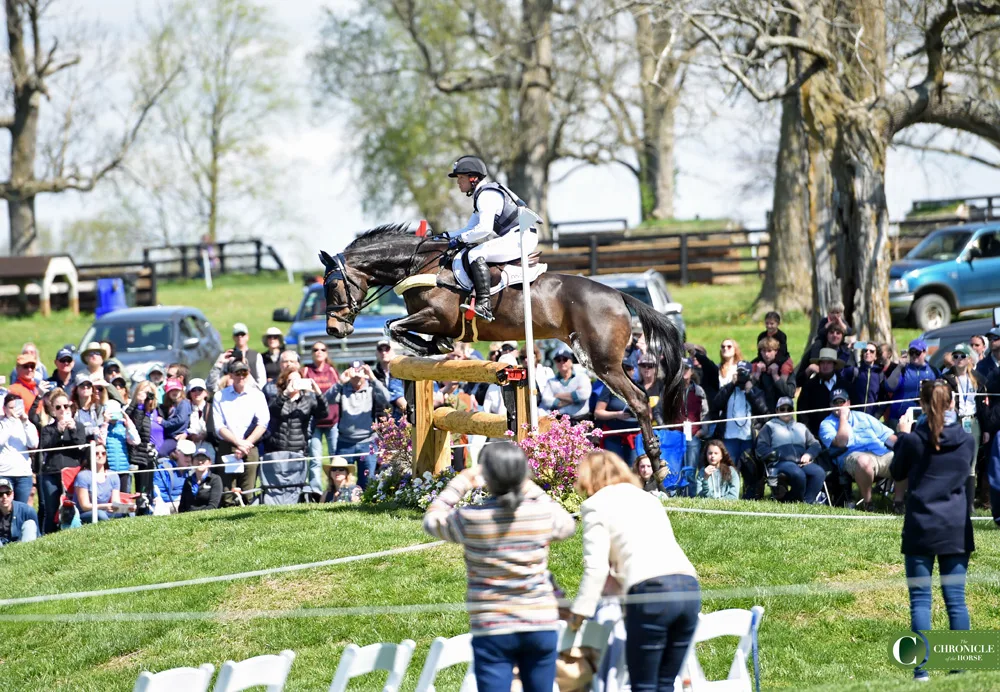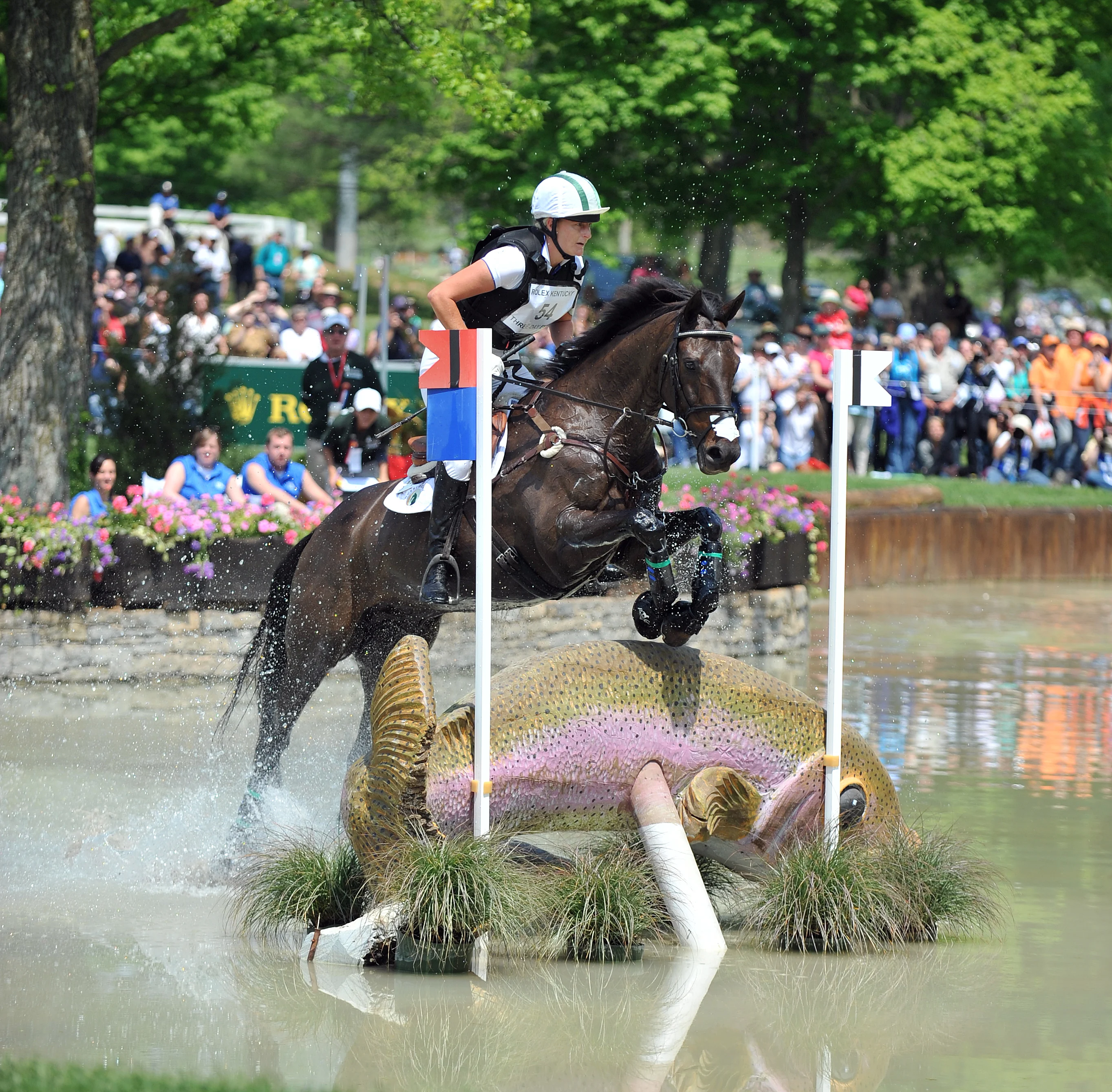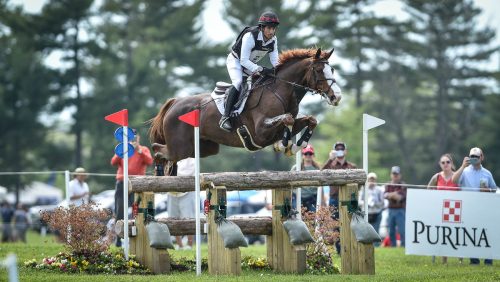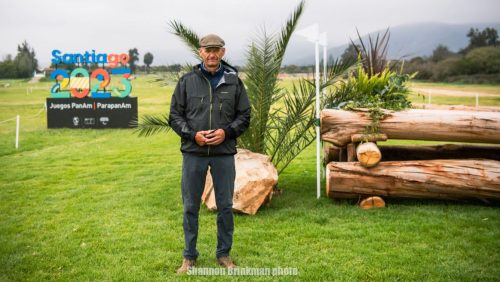When the announcement came out on Feb. 2 that Equestrian Events Inc. was canceling the Land Rover Kentucky Three-Day Event for the second year in a row due to the COVID-19 restrictions for spectators, the eventing community jumped into action and active debate.
Some rallied behind a last-minute effort to fundraise the money EEI needed to run the event without spectators, while others questioned why an event with connections to large corporate sponsors and wealthy horse owners was asking grassroots supporters for donations in an economic climate still ravaged by the effects of COVID-19.
On Feb. 10, EEI announced that, thanks to grassroots fundraising and several big dollar donations, the five-star event is back on. But how did the event get into this situation, and how is it proceeding from here? EEI Executive Director Lee Carter and Clay Green, chairman of the board of the Kentucky Horse Park Foundation, sat down to answer some hard questions.

Lee Carter, executive director of Equestrian Events, Inc., discussed the rollercoaster ride of deciding to run the 2021 Land Rover Kentucky Three-Day Event. Red Bay Group LLC Photo
Let’s start at the beginning. When last year’s event was canceled, what happened next? When did you start thinking about this year, because last spring I don’t think anyone thought we’d be facing these same problems now.
We made the decision to cancel on March 25 last year, and it became an issue of how do we make sure we have enough money to refund everyone, the spectators, the sponsors, the vendors, so we gave everyone the option to get a refund or defer to 2021, and we had about $950,000 roll forward, which was great because it allowed us a little bandwidth. We also applied for a Payroll Protection loan, which we got. We maxed out our line of credit, because at the time we were thinking, “Let’s get to a point where we can open entries for the [USEA American Eventing Championships],” but the AECs ended up having to cancel.
What happened next?
The Payroll Protection money ran out. We have eight people who work year-round, so we had to furlough two of the full-time staff; we had to terminate two staff. Everyone across the board had a reduction in benefits and compensation. We were just trying to manage through to 2021.
We started having conversation internally about what April 2021 would look like in June or July. We planned all these what-ifs and scenarios, the social distancing requirements, how would the trade fair look, how would sponsorship tents look.
Was one of those what-if scenarios a plan to run without spectators?
Our plan was always based off 50%, and part of the challenge in COVID right now is you have no consistent restrictions state to state. Florida can do X, and Kentucky can do Y, but the U.S. Equestrian Federation parameters supersede all of that because we have to run under those guidelines.
We had communicated to the USEF all along that 50% was our number, financially. To run with zero percent really wasn’t an option, so we started having biweekly meetings with U.S. Equestrian starting in October saying, “OK, what do we think it’s going to look like?” At that point, COVID numbers were going down, but we knew the holidays were going to create issues.
As of Dec. 15 or so everyone involved in those meetings including USEF was confident we would be running with 50%, so we said great. We planned for Jan. 12—that was the date we were going to launch tickets. Then we decided to push it back until after the USEF board meeting, which I think was the weekend following that, but so everybody was good, right? And then we came out the first of the year, and we knew there was going to be a spike in numbers from holidays, so we wanted to be sensitive in the messaging. I agreed with USEF; it felt insincere when numbers were going up to say, “Hey we’re going to run an event with a lot of spectators.” We wanted to align our message with numbers going down, so by the time we got to that point or were getting closer to that point the second strain of the virus started popping up. And you heard how much more transmittable it was, was it going to respond to the vaccine, the vaccine had just started, and the early rollout was maybe less organized than our current plan, so then that became an issue.
We finally had to say to USEF, “We know the challenges, but we have to make plans.” While we had all of our internal plans with a lot of what-ifs, we had to go to people and sign contracts, make sure we had our officials hired, and we had it all on the edge ready to go but couldn’t pull the trigger, so we identified Feb. 1 as our date to hear from USEF on OK, are we going, or are we not going with 50%.
We start getting a few days out from that date, and 50% is looking difficult, and the conversation was, “Well maybe we start out offering 10% of the tickets, and as things go on we open up more and more tickets and eventually get to 50%,” but there was no guarantee. If we try and don’t then I’m in an even worse spot because I have to pay all these people back. So that’s when the decision was made to cancel, Feb. 1.
So you cancel the five-star but are planning on going ahead with the four-star?
Yes, the four-star was always part of the plan. I think there is a misunderstanding that we swapped the five-star out for a four-star short when we canceled. That wasn’t the case. We applied for these licenses at the same time; we were always going to run both.

The Land Rover Kentucky Three-Day Event can draw upwards of 30,000 spectators on cross-country day alone. Kimberly Loushin Photo
Did you make an effort to get that money you’re not going to get from spectators from other sources? From USEF, since the event doubles as their national championship, or the U.S. Equestrian Team Foundation?
We did go to the U.S. Equestrian Team Foundation to see if we could get a grant from them, and I can’t remember the exact timing, but we either missed their deadline for the grants, or they have a schedule for grants that we didn’t fall into.
And they weren’t willing to work with you on that?
Not that I’m aware of, no. But I mean again, up until Jan. 20, Jan. 25, I think everyone is really thinking we are going to run with 50% spectators, and if we have 50% spectators we don’t need all this money.
[Bonnie Jenkins, executive director of USET Foundation, said they were “not aware of being approached by Equestrian Events Inc. with regard to this event.” She added that, “As the philanthropic partner to USEF, the USET only provides grants to USEF for its High Performance program, along with select grants for athletes that are supported by specific donor-designated funds, and as a matter of policy , the USET does not directly support specific events or competitions.”
What about USEF? If I understand correctly USEF controls the livestream rights. Was there anything that could be done there to raise funds like a pay-per-view system?
We approached members of USEF who we thought would be in a position to help, but no, we didn’t approach USEF as an organization directly.
ADVERTISEMENT
With the livestream, you’re correct they do own those broadcast rights, but it’s important for them and important for us to continue to expand the equine community and that we make the broadcast available to as many people as possible; we don’t want people to have to pay for it. You want the Kentucky Derby to be free on NBC; you want the Land Rover Kentucky Three-Day to be free wherever it’s playing.
What about reaching out to owners and riders? I’ve talked to some riders who say no one ever reached out to them or their owners about money to fund this, and that if they had been contacted earlier maybe they could have helped.
We did a campaign last fall, Share The Love. We sent out a lot of letters and connected with a lot of people and had some success but not enough success to run a five-star event proper.
We had riders do a video for us. Ollie Townend was in it; several riders participated, so we did try to engage. You know EEI is not in the fundraising business. We don’t have experience with this. We’re in the event production business, so I am very sorry if people feel like we didn’t do as good of a job as we could of. We don’t have a lot of experience with this. There wasn’t any intent on our part not to get it out there.
Did you approach some of these big sponsors and say, “Hey, we’re in danger of not running this year. Will you up your commitment and help us run this event this year?”
That’s a tricky thing. You start dealing with corporations with budgets that are tied to performance and a return on investment. It’s hard to say, “Hey be benevolent.” Most don’t operate in that fashion, and we dealt with this with sponsors at every level saying, “Hey we’re going to have reduced attendance.” They look at, “Well what does that mean? It means fewer sales, fewer revenues, so we can’t pay you what we would normally pay you.” At that level there has to be return on the investment. These are global companies that had things like supply chain issues in the automotive industry related to COVID, so I don’t know if companies had that flexibility.
But we’re talking about million- and billion-dollar entities here. Do you understand peoples’ frustration that this is an event where luxury car and watch brands are written on the fences, and people are out here getting stimulus checks hoping they’ll be paying the bills next month, and you’re telling us, “Well it’s going to cut into their profit margins too much to give more money, so can you guys donate to our event?”
I absolutely understand that. That is a completely fair viewpoint folks have, but regrettably, I don’t sit on these company’s boards, so I can’t make those decisions. But these sponsors were all committed to participate in 2021, so no, we didn’t say, “Hey we’re going to cancel unless you do XYZ.” We didn’t engage with them in that way.
Our big three sponsors have been in it from the beginning. They said, “We get it.” They’ve had other events get canceled, and they recognize what everyone is struggling with right now, so they’ve been great. They’re looking at it as an investment in the event and the community, and let’s keep it going, and they’re getting a reduction in the rate they usually pay, but it’s not significant given there may be no spectators. They could have all backed out, but they have all come around and jumped in and have been very supportive, and they’re part of the reason we’re going to be able to do this.
The other part of why it’s going to go off this year is the money raised from the grassroots effort. If I understand correctly, Sara and Brian Murphy approached you and asked what they could do to make this event happen. Is that right?
Yes, correct, that’s what happened. We got a call one evening, and they said, “Hey, would you be willing for us to take this on? How much would we have to raise?” And we felt like based on the response of the eventing community and how much people wanted to see this event go on, we wanted to give it a try. So Brian and Sara said, “What’s the number?” We told them $1.5 million, and obviously that’s a huge number. And they said, “OK, what would we need to get for you to start reconsidering running this?” and we halved it and said $750,000, because I felt like if we could get there, there are some other things we can look at to try and shrink that $1.5 million price tag further and then see what other partnerships and revenue can we tap into to close the gap.

A frequent Kentucky competitor, eventer Sara Kozumplik Murphy helped lead the charge to raise money to save the 2021 Land Rover Kentucky Three-Day Event. Chronicle Archives Photo
The Badminton Horse Trials is running “behind closed doors” in England. They don’t appear to be fundraising. What’s different about what they’re able to do versus Kentucky?
So Badminton behind closed doors, that is essentially what we’re doing now. Badminton is in a different position. They run on this duke’s private estate there, and my understanding is, other than when the horse trials are there, it’s just the estate, it’s private land, and my understanding is the horse trials help pay the property tax on the land.
The $750,000 number, I think a lot of people were shocked that it costs that much to run an event of this caliber, and you’re saying really it’s more like $1.5 million. Can you break that down for me? What are the big-ticket costs that make that number so huge?
In a normal year it costs us around $4 million to run the event, and that’s with spectators and all the things. Then you look and say, “OK, what does it take to run it without spectators?” That number is $1.5 million. That includes building cross-country jumps, designing the course, stabling, paying for all the officials, the horse park rental, the food and beverage, the prize money. And then when you run an FEI event there are all these things you’re required to have, anything from closed-circuit TV to having golf cart rentals available, it’s an exhaustive list. And we have been in touch with them since the grassroots fundraising efforts have begun about getting allowances for some of the different rules like offering less prize money, but at the same time if they make an allowance for us they have to make an allowance for all the five-stars.
What are the biggest costs?
In a traditional year, we pay $200,000 in rent to the horse park. We’re in talks to try to negotiate that down because we won’t need as much space if we don’t have spectators. We pay $400,000 in prize money, which this year we’re looking at paying more like $155,000, and some things don’t change in cost depending on COVID; they don’t change with or without spectators. The cost to build a five-star course is the same whether or not anyone sees it. We probably spend $250,000 on the course, easily, because you also have to think about the footing—we go above and beyond to treat our course all year round, so that’s got an expense—then you have to build the jumps, install the jumps, rope the galloping lanes, all those expenses.
Sara and Brian—and I understand Dorothy Crowell helped a lot too, among others—had a lot of success in raising money toward that number.
Yes, it’s been unbelievable, the effort that those have put in on the grassroots level, and the response has been tremendous. It’s been incredible to see how much the eventing community has rallied behind the event. And because of the incredible response we saw from the public, other things have started moving. That’s where the partnership with the Kentucky Horse Park Foundation comes into the picture. I’m going to hand things off to Clay Green from the foundation to talk a little bit about that.
Thanks for joining the conversation Clay. Can you explain what the Kentucky Horse Park Foundation is doing this year to help the event?
We are a nonprofit foundation; our whole mission is supporting the Kentucky Horse Park, and as a part of that we put on different events at the horse park. People in Lexington probably have seen our Southern Lights Christmas light displays; that’s the Kentucky Horse Park Foundation. Legally we can’t donate money directly to EEI to make the event happen, but what we can do is partner with EEI and run the event as a partner, and that allows us to put money directly toward event expenses like we would with any other event.
This event, it’s so critical to the park. It’s one of the reasons the park is what it is today, and all the success we’ve had over the years stemmed from the world championship event we had way back in 1978. It’s high profile; it’s the Super Bowl of equestrian sport, and we wanted to make sure it stayed at the Kentucky Horse Park.
When we saw that the event was in danger of not running, Lee and I started having conversations about what a partnership could look like and how we could help, and as we started seeing the response from the eventing community rallying behind an initiative to pull this event off, our conversations accelerated at warp speed. But the reason this is really happening is because of the grassroots marketing and the amount of people that engaged the challenge of coming together and communicating that this is a super important event. The public is showing they have great interest in it, and we just have to find a way to make it happen.
ADVERTISEMENT
The Horse Park Foundation is in the fundraising business, unlike EEI, so we’ve got the training and the staff and the computer programs and things to take over spearheading that effort, and we’re about to announce that we’ve received a $125,000 matching grant fund from an anonymous donor foundation. Typically how fundraising works if you’re trying to build a museum or a hospital or whatever, you go out and raise 60 or 70 percent of the funds before you even announce that you have a campaign, because you don’t want to announce it and have it fail, so you raise most of the money and then announce it to the general public. This was just an amazing situation where the general public raised most of the money themselves before we had a chance to start talking to the big donors, and now the big donors are going to be the ones to close the gap, so it was kind of an unusual flip flop.
Does the foundation have any control over what EEI is paying to rent the horse park, that big $200,000 number?
The foundation doesn’t set the rates or negotiate contracts on renting the park. The horse park is a state-owned park, and there is a Kentucky Horse Park commission that is appointed by the governor of Kentucky. It’s about 15 people, so they make the decision. But really it’s kind of like USEF’s blanket rule for no spectators; we can’t really make an exception for one event and greatly reduce a rental fee without doing that for everyone.
But to be fair, as you said yourself, this isn’t every other event. It’s the event. It’s the reason we have a Kentucky Horse Park, so isn’t there an argument that this event can be treated differently?
I get where you’re coming from, and it’s definitely going to be a lot lower than the usual rate with how much less space we’re using this year. But to be clear, the other part of this is this event starts getting built April 1. It takes 3 ½ weeks to build this up with the tents and vendor village and everything, and it’s tearing down for 10 days after the event. It’s on the property that whole time using the facility, so I think if you think about how it’s all structured the rate becomes more reasonable, and obviously because we won’t have nearly the same number of spectators there won’t be those big setups and teardowns of some of those things, so that will affect the rate as well.
Lee, to date how much money has been raised? How much more do you need?
I haven’t gotten a recent number—we’ve moved that process over to the foundation—so I’m not sure, but it’s north of $600,000, $650,000. But even if you assume we were at $550,000, and then we have this matching grant, so if we get it matched we’re suddenly at $800,000.
If that happens then how far off are we from running?
We’re running. It doesn’t matter how far off, we’re running, and the Kentucky Horse Park Foundation is going to cover any shortfalls, but the foundation is in the business of raising money, so we are going to continue raising money, and it will all go to this event.
I think it’s important for people to know we are going to be so conservative with these donations. We aren’t going to sacrifice rider or horse safety, but we really want to be thrifty with the funds that have been donated, just like we would with any donation. We are very, very cautious about it, and we aren’t just wasting money, because it’s hard to raise, and we want to make sure we respect those who gave.
Was there any danger of Kentucky not running again if you didn’t run the five-star this year?
From a licensing standpoint, if a license is canceled because of COVID, it just rolls forward. From a financial situation, if 2020 taught us anything it’s never say never. If we had to refund all the monies could we not exist anymore? Maybe, but no the event was not going to get taken away by the USEF or by the FEI if we didn’t run this year.
Some of us have concerns that while this event will be “closed to the public,” there will still be VIP tables and tents for those wealthy enough to get them. What will Kentucky be doing with regards to sponsor or VIP tables and tailgating and things like that?
That’s one of the things on our agenda to talk about because we have to be overly sensitive to that: We have to be able to provide certain things. We have to feed our athletes and that kind of thing, but the last thing we need is to see a large tent next to the Rolex arena with a bunch of people sitting in there eating and drinking and creating the perception that, “Well you paid for this with your grassroots donations, but look who is sitting in the tent.” We know a lot of the people who gave to us didn’t have all kinds of extra money sitting around, so we really want to respect that.
And it’s something that will have to have a back-up plan because we are hopeful as we get closer to the date of the event that maybe USEF’s rules will change and allow for some small percentage of spectators, and if that happens we’re going to have to think about how we offer that small percentage of tickets to people. Maybe we draw names out of a hat or do a lottery system because we want to make sure it’s fair for everyone.














